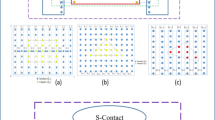Abstract
The conduction band structure of Si under uniaxial [100] stress is investigated by using the two band k·p perturbation theory. The conduction band parameters, including the conduction band minimum energy shift, split and electron effective mass change are quantitative described. Based on these band parameters, uniaxial stress induced electron mobility enhancment is systematically studied through Boltzmann transport theory. The results show that, when uniaxial [100] stress is applied to Si crystal, a gain of more than 50 % in electron mobility can be obtained. The electron mobility along the [100] increase with tensile stress and decrease with compressive stress, while does the opposite for the electron mobility along the [010] and [001]. The electron mobility along the [100], [010] and [001] tend to saturate for stress beyond a certain level. The stress induced the reduction of conductivity effective mass and the suppression of inter-valley scattering rate are responsible for the enhancement of electron mobility. The calculated results provide valuable reference for the optimum stress and orientation of the conduction channel in the uniaxial strained Si nMOS devices design. The electron mobility calculated model used in the present work is suitable for implementation in TCAD simulators.
Similar content being viewed by others
References
Baykan MO, Thompson SE, Nishida T (2010) J Appl Phys 9:093716
Thompson SE, Sun G, Choi YS, Nishida T (2006) IEEE Trans Electron Devices 5:1010–1020
Flachowsky S, Wei A, Illgen R, Herrmann T, Hontschel J, Horstmann M, Stenzel R (2010) IEEE Trans Electron Devices 6:1343–1354
Thompson SE, Sun GY, Sung YC (2006) IEEE Trans Electron Devices 5:1010–1020
Irisawa T, Okano K, Horiuchi T, Itokawa H, Mizushima I, Usuda K, Tezuka T, Sugiyama N, Takagi SI (2009) IEEE Trans Electron Devices 8:1651–1658
Dhar S, Kosina H, Palankovski V, Ungersboeck SE, Selberherr S (2005) IEEE Trans Electron Devices 4:527–533
Decai Y, Yu Z, Liu F (2008) Phys Rev B 24:245204
Kima J, Fischetti MV (2010) J Appl Phys 1:013710
Bir GL, Pikus GE (1974) Symmetry and strain-induced effects in semiconductors. Wiley, New York
Sverdlov V, Karlowatz G, Dhar S, Kosina H, Selberherr S (2008) Solid-State Electron 10:1563–1568
Seeger K (1973) Semiconductor physics. Springer, New York
Ferry DK (1976) Surf Sci 1:218–228
Tang JY, Hess K (1983) J Appl Phys 9:5145–5151
Fischetti MV, Laux SE (1996) J Appl Phys 4:2234–2252
Kotlyar R, Giles MD, Cea S, Linton TD, Shifren L, Weber C, Stettler M (2009) J Comput Electron 2:110–123
Maegawa T, Yamauchi T, Hara T, Tsuchiya H, Ogawa M (2009) IEEE Trans Electron Devices 4:553–559
Seo WH, Donegan JF (2003) Phys Rev B 7:075318
Schaffler F, Herzog HJ, Jorke H, Kasper E (1991) J Vac Sci Technol B 4:2039–2044
Jacoboni C, Canali C, Ottaviani G, Quaranta A (1977) Solid State Electron 20:77–89
Author information
Authors and Affiliations
Corresponding author
Rights and permissions
About this article
Cite this article
Ma, J.L., Fu, Z.F., Wei, Q. et al. Uniaxial Stress Induced Electron Mobility Enhancement in Silicon. Silicon 5, 219–224 (2013). https://doi.org/10.1007/s12633-013-9144-4
Received:
Accepted:
Published:
Issue Date:
DOI: https://doi.org/10.1007/s12633-013-9144-4




